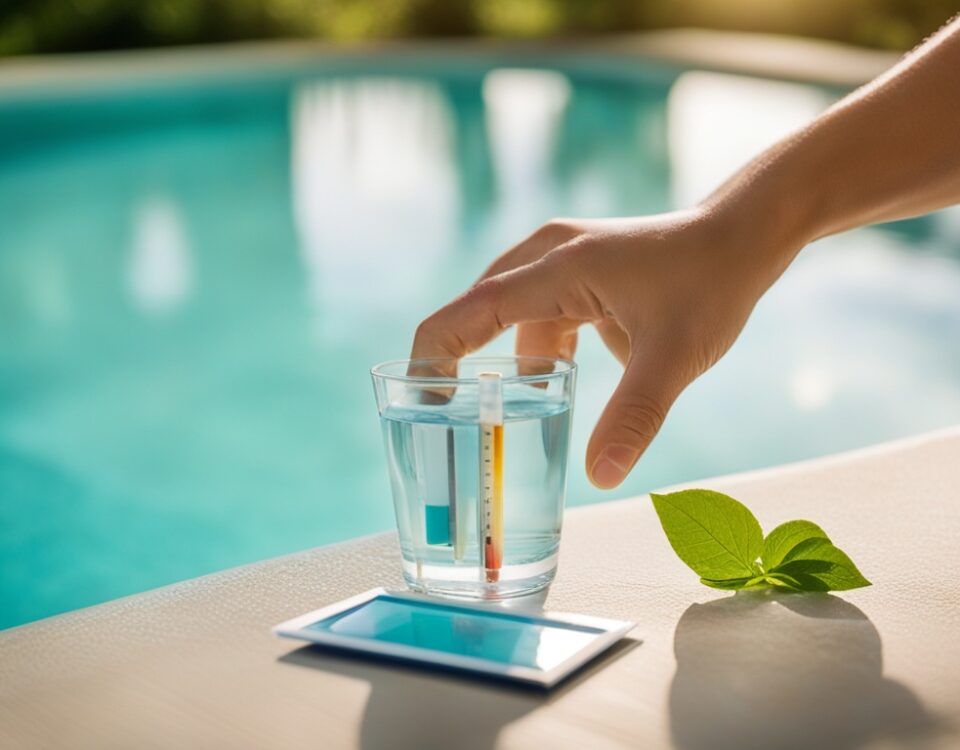Rainy Mess? Quick Tips to Revive Your Pool After the Storm!

Decoding Pool Heater Types: Your Complete Guide
May 13, 2025
Master the Art of DIY Pool Building with These Expert Tips
May 15, 2025Assess the Damage
After a rainfall, the charm of an inviting swimming pool can swiftly turn into a murky oasis of debris and contaminants. To restore your pool to its pristine condition, it is crucial to meticulously assess the damage. This initial step paves the way for an effective cleaning process, ensuring you address all aspects of pollution brought by the resilient forces of Mother Nature.
Inspecting for Debris
Begin your assessment by visually scrutinizing the pool for any obvious signs of debris. Rain can carry organic matter—such as leaves, twigs, and dirt—into your pool, creating a veritable soup of unwanted materials. Make a thorough walk around the pool’s perimeter, looking for large items that may have found their way into the water. Remove these pieces promptly, as they can decompose and exacerbate water quality issues if left for extended periods.
Examining Water Clarity
Next, turn your attention to the clarity of the water. A clear swimming pool is indicative of proper filtration and chemical balance, while cloudy water can be a sign of contamination. Use a pool water test kit to measure several parameters, including pH, chlorine levels, and total alkalinity. Not only do these readings reflect the current state of your pool’s water quality, but they also inform how extensive your cleaning efforts need to be.
Checking Water Level
In addition to clarity, it is imperative to check the water level after rainfall. Heavy rain often leads to water overflow, diminishing water quality and causing it to become unbalanced. If the water level is significantly high, you may need to use a submersible pump to remove the excess. Moreover, aim for a balance of at least 4 to 6 inches below the skimmer for optimal filtration.
Identifying Other Contaminants
Look out for any additional contaminants that may have entered the pool during the rain—such as mud, algae growth, or even chemicals from surrounding areas. More often than not, particularly after heavy rains, algae can find fertile ground to start flourishing in your pool. If you spot any green or brownish tints, you are likely facing an algae bloom that requires immediate intervention.
Table of Common Contaminants and Their Impact
| Contaminant Type | Source | Impact on Water Quality |
|---|---|---|
| Leaves | Heavy rainfall | Can decompose, raising levels of organic waste |
| Dirt and Mud | Rain runoff | Cloudy water, can lead to algae growth |
| Algae | Warm water with nutrients | Compromises water clarity and can be hazardous |
| Pesticides/Chemicals | Surrounding plants and soil | Can disrupt chemical balance, harmful to swimmers |
In summation, assessing the damage to your pool after rain is a meticulous task that requires careful observation and immediate action. By transparently gauging debris levels, water clarity, and overall water health, you can lay the foundation for a comprehensive and effective cleaning regime.
Skim and Remove Debris
After a rainstorm, your pool may resemble a mini swamp, with leaves, twigs, and an array of other debris floating upon its surface. The first step in restoring your pool’s pristine condition is to skim and remove debris promptly. Using a skimmer net is an essential and effective tool for this task, allowing you to capture unwanted particles before they sink to the bottom and complicate the cleaning process.
Utilizing the Skimmer Net
To begin, grasp your skimmer net firmly and glide it across the surface of the water. Let the net do the work by allowing it to capture the floating debris. It is crucial to move slowly and methodically; this technique ensures you don’t miss any of the items that may have become trapped in the eddies created by the rain. Be vigilant, as items such as fallen leaves can harbor bacteria and contribute to algae growth if not removed promptly.
Regularly Empty the Skimmer Basket
While skimming may feel straightforward, it is essential to remember that debris can accumulate quickly. After every session, you must empty the skimmer basket to prevent blockages that could obstruct optimal water flow. A clogged skimmer basket not only hampers efficient cleaning but could also lead to increased strain on your pool’s pump, potentially shortening its lifespan.
Tips for Effective Skimming
To enhance the effectiveness of your skimming efforts, consider these practical tips:
- Always maintain an organized cleaning station with your skimmer net easily accessible for quick deployment.
- Consider using a net with a deep bag design, which can capture a larger amount of debris at once.
- Set a designated time post-rain to inspect and clean your pool, as immediate action helps reduce the chance of algae development.
Assessing Debris Volume
| Type of Debris | Impact on Pool Health | Recommended Skimming Frequency |
|---|---|---|
| Leaves | Can cause algae growth if left unattended | Every day |
| Twigs | Affects water circulation; potential clogs | Every other day |
| Pollen | Can lead to murky water | After every rainstorm |
Overall, mastering the art of skimming and removing debris from your pool is integral to maintaining its health and beauty. Consistent skimming not only improves the water’s clarity but also sets the stage for a more efficient cleaning routine. Ultimately, your attentiveness to this crucial cleaning task paves the way for many enjoyable days spent by the water.
Brush and Scrub the Walls
After a rainstorm, pools often become repositories for various debris, dirt, and unwanted algae. Once you’ve removed the large obstacles such as leaves or branches, it’s essential to thoroughly clean the walls and floor of your pool. This meticulous process not only enhances the aesthetic appeal of your pool but also maintains the quality of the water, ensuring a safe swimming environment.
The Importance of Using a Pool Brush
A pool brush is an indispensable tool in your arsenal for maintaining a clean and inviting pool. Unlike regular cleaning brushes, a specialized pool brush is designed with bristles that effectively remove stubborn dirt and algae without damaging the pool’s surface. Whether your pool is made of plaster, tile, or fiberglass, using the appropriate brush ensures that each surface is adequately cleaned while preserving its integrity.
Methodology for Effective Cleaning
To initiate the cleaning process, it’s advisable to start with the walls. Using a long-handled pool brush, begin at the waterline and work your way down. This approach prevents dirt and debris from settling back after you’ve disturbed it. Be sure to use a firm hand and make sweeping motions to dislodge any algae or stains that may have taken residence post-rain. It’s crucial to pay special attention to corners and crevices where dirt and algae tend to gather unnoticed.
| Surface Type | Recommended Brush Type |
|---|---|
| Plaster | Stiff bristle brush |
| Tile | Medium bristle brush |
| Fiberglass | Soft bristle brush |
Focusing on Stains and Algae
Particularly during wet weather, algae growth can escalate, posing a risk to the health of your pool and its inhabitants. When scrubbing, channel your energy towards areas exhibiting discoloration or slick surfaces, as these typically indicate algae presence. Using a combination of brushing and non-chlorine shock treatments can drastically reduce algae buildup which can proliferate after a rain.
Consistency is Key
Regular brushing is not only a post-rain necessity but a fundamental aspect of long-term pool maintenance. Establishing a routine that includes scrubbing the pool walls and floor at least once a week will help to keep your pool pristine and free of unsightly growths. In this way, the cleaning process is less labor-intensive, and the results are more satisfying.
Post-Cleaning Essentials
After the brushing and scrubbing of the walls, it is advisable to vacuum the pool to effectively remove the debris that has settled to the bottom. Additionally, monitoring your pool’s chemistry post-cleaning ensures that the water remains balanced and clear, thus safeguarding swimmer health and prolonging the life of your pool infrastructure.
Test and Adjust the Chemical Levels
After rainfall, it is crucial to test and adjust the chemical levels in your pool to maintain a safe swimming environment. Rainwater can significantly dilute the chlorine in your pool, thereby disrupting the carefully balanced ecosystem that ensures water quality and swimmer safety. Utilizing a pool testing kit is imperative in this process; these kits typically measure pH, free chlorine, total alkalinity, and stabilizer levels, providing a comprehensive view of your pool’s chemical status.
Understanding the Key Chemical Levels
To grasp the importance of adjusting your pool’s chemistry, it helps to understand the key measurements:
| Chemical | Ideal Range |
|---|---|
| pH Level | 7.4 – 7.6 |
| Free Chlorine | 1 – 3 ppm |
| Total Alkalinity | 80 – 120 ppm |
| Stabilizer (Cyanuric Acid) | 30 – 50 ppm |
pH levels are paramount, as they affect the effectiveness of chlorine. If the pH is too low, chlorine becomes more acidic, which may irritate the skin and eyes of swimmers. Conversely, a high pH level can lead to reduced chlorine efficacy and cloudy water. Therefore, after a rainfall, measuring the pH should be your first step in chemical adjustment.
Next, the free chlorine levels must be examined. Rain can wash away the chlorine from your pool, allowing harmful bacteria and algae to flourish. Ideally, maintain free chlorine levels between 1 to 3 parts per million (ppm). If the levels are below this range, consider adding chlorine tablets or liquid chlorine to restore balance. Keep in mind that the adjustment of chlorine levels may take some time, so patience is key.
The total alkalinity serves to stabilize the pH levels in your pool. This component acts as a buffer, preventing rapid fluctuations in pH due to external factors like rain. A total alkalinity reading between 80 to 120 ppm is deemed ideal. Should your levels fall outside this range, you may need to add an alkalinity increaser, often composed of sodium bicarbonate, or a decreaser if your alkalinity is too high.
Lastly, don’t overlook the importance of stabilizer, also known as cyanuric acid. This compound protects chlorine from being broken down by the sun’s ultraviolet rays and helps maintain its effectiveness. Following rain, it’s wise to check these levels and add stabilizer as needed to keep your pool chemical framework robust.
Shock the Pool
After a rainstorm, your pool may experience an influx of contaminants, including bacteria and algae. To ensure crystal-clear water and a healthy swimming environment, it is crucial to shock the pool. This process involves applying a pool shock treatment, which is designed to kill any unwanted organisms that may have proliferated during the storm.
Understanding Pool Shock Treatment
Pool shock comes in various forms, including chlorine-based and non-chlorine options. The primary purpose of shocking your pool is to raise the chlorine levels temporarily, creating an environment that is hostile to harmful microorganisms. For the best results, it is essential to choose the right type of shock for your pool based on the specific conditions and contaminants observed after the rain.
When to Shock Your Pool
Typically, it’s advisable to shock your pool after heavy rainfall or storms that have disturbed the water chemistry. If you notice cloudy water or an unexpected increase in algae, it is a clear indication that your pool requires shocking. A good rule of thumb is to test your pool water immediately after the rain; if the chlorine levels drop below acceptable ranges (1-3 ppm), you’re likely in need of a shock treatment.
Dosage and Application
Following the manufacturer’s instructions for dosage is vital for achieving optimal results. Most pool shock treatments recommend a specific amount based on the pool’s volume. Below is a general guideline to help you adjust the dosage accordingly:
| Pool Volume (Gallons) | Shock Dose (Pounds) |
|---|---|
| 10,000 | 1-2 |
| 20,000 | 2-4 |
| 30,000 | 3-6 |
To apply the shock treatment, dissolve the recommended dose in a bucket of water before adding it to the pool. This method ensures even distribution and maximizes its effectiveness. Broadcast the solution evenly across the surface of the pool while ensuring that the circulation system is running to promote thorough mixing.
Post-Shock Considerations
After shocking your pool, it is imperative to monitor the water chemistry diligently. Test the chlorine levels periodically to confirm they return to safe swimming levels (1-3 ppm). Ideally, you should wait at least 24 hours before allowing anyone to swim in the water, as this ensures that the shock has effectively done its job without exposing swimmers to elevated chemical levels.
In addition to maintaining chlorine levels, consider adding an algaecide if algae blooms are a recurring issue. This preventive step can help fortify your pool against future rain-related contaminations and contribute to a healthier swimming environment.
Run the Filtration System
After a rainstorm, the water quality in your swimming pool can become compromised due to debris, dirt, and contaminants that might have washed in. To restore your pool to its pristine condition, it is essential to run the filtration system effectively. This step will not only help in clarifying the water but also in maintaining a healthy swimming environment.
Understanding Filtration System Efficiency
To ensure that your pool filtration system operates at peak efficiency, begin by checking the pressure gauge. This device provides a clear indication of the system’s performance. Ideally, the pressure should be within the normal range specified by the manufacturer. A pressure reading that exceeds this range often signals that the filter is obstructed by dirt and requires immediate attention. Regular monitoring of this gauge is crucial, especially after significant rainfall.
Backwashing the Filter
When you detect an elevated pressure reading, the next course of action is to backwash the filter. Backwashing is a process that cleans the filter by reversing the flow of water, allowing trapped debris to be expelled. This procedure ensures optimal performance and prolongs the lifespan of the filtration equipment. Depending on the filter type—sand, cartridge, or diatomaceous earth (DE)—the backwashing process may vary. Always refer to the manufacturer’s instructions for specific guidelines.
Routine Maintenance Checks
In addition to backwashing, conducting routine maintenance checks on the filtration system is essential for ongoing efficiency. Inspect the filter media for signs of wear or tear, and replace it when necessary. Additionally, ensure that all connections are secure, and there are no leaks that could reduce the system’s effectiveness. A well-maintained filtration system not only improves water clarity but also enhances overall pool sanitation.
Utilizing Automatic Pool Cleaners
While the filtration system plays a vital role, it is also beneficial to integrate automatic pool cleaners into your post-rain cleaning routine. These devices work in conjunction with the filtration system to remove larger debris from the pool floor and walls. Choose a cleaner that suits your pool type and size to maximize results. The combination of a running filtration system and an automatic cleaner can significantly expedite the cleaning process.
Effective Pool Monitoring
Lastly, after ensuring that the filtration system is operational and handling debris efficiently, continually monitor the water chemistry. Following rain, pH and chlorine levels may fluctuate, and using a reliable test kit can help you adjust these parameters accordingly. Maintaining optimal water balance is crucial for both the health of swimmers and the integrity of the pool equipment.
| Filtration System Maintenance Checklist | Frequency |
|---|---|
| Check pressure gauge | Weekly |
| Backwash filter | As needed (when pressure is high) |
| Inspect and replace filter media | Every season |
| Check for leaks and secure connections | Monthly |
| Monitor water chemistry | Weekly |
Maintain Regular Cleaning Schedule
Establishing a regular cleaning schedule for your swimming pool is paramount, particularly during the unpredictable rainy season. By adhering to a consistent maintenance routine, you effectively minimize the accumulation of debris and contaminants that can compromise water quality. Regular maintenance not only enhances the longevity of your pool but also ensures a safe and enjoyable swimming environment for you and your family.
Why a Cleaning Schedule is Essential
The aftereffects of rain can be detrimental to your pool’s cleanliness. Rainwater can introduce sediment, leaves, and other organic materials into your pool, creating an environment conducive to algae growth and bacteria proliferation. Therefore, a well-planned schedule is essential for keeping your pool water crystal clear and free from impurities.
Recommended Cleaning Frequency
During the rainy season, increase your cleaning frequency to at least twice a week. This proactive approach not only prevents the buildup of contaminants but also lessens the workload during heavy rains. At a minimum, consider dedicating 30 minutes each session to skimming debris, vacuuming, and testing water chemistry to maintain optimal balance.
| Cleaning Task | Frequency | Time Required |
|---|---|---|
| Skimming Surface Debris | Every 1-2 Days | 5-10 Minutes |
| Vacuuming Pool Floor | 2 Times a Week | 20 Minutes |
| Brushing Walls and Tiles | Weekly | 15 Minutes |
| Testing Water Chemistry | 2 Times a Week | 5 Minutes |
Effective Post-Rain Maintenance
After a heavy rainfall, it’s crucial to conduct a thorough cleaning immediately. Start by removing any large debris using a skimmer net. Next, adjust your pool’s filter settings to run continuously for 24 to 48 hours to facilitate the removal of finer contaminants. Additionally, test the water chemistry to ensure pH and chlorine levels are balanced, as rain can often skew these parameters.
Invest in Quality Tools
To maintain an effective cleaning schedule, investing in high-quality cleaning tools is essential. A reliable vacuum, durable skimmer, and efficient pool brush can make the difference between a compliant maintenance routine and one that falls short. By equipping yourself with the right tools, you will find that keeping your pool pristine becomes a more manageable and less daunting task.
Keep a Cleaning Log
Finally, maintaining a cleaning log can augment your efforts to keep the pool clean. Document dates, tasks performed, and any adjustments made to water chemistry. Not only does this practice help in establishing a more profound understanding of your pool’s maintenance needs, but it also allows you to observe patterns, such as increased debris post-rainfall, thus informing future cleaning schedules.
Learn more about Maintenance & Cleaning

Javier Morales is passionate about pool design, maintenance, and outdoor living. With years of hands-on experience, he offers practical tips, creative ideas, and expert insights to help readers make the most of their pool spaces. At Piscina Planet, Javier shares everything from seasonal care guides to the latest trends in pool innovation.




